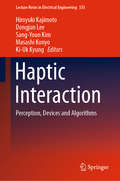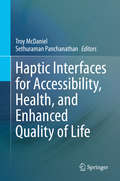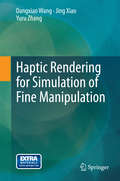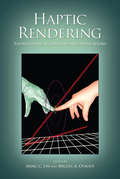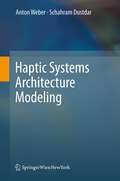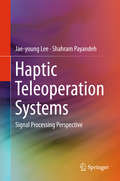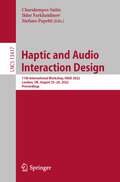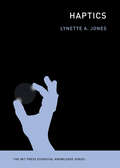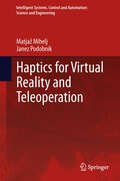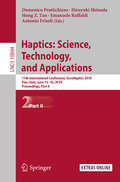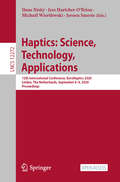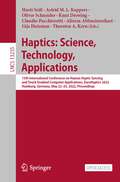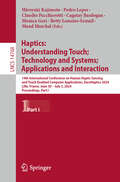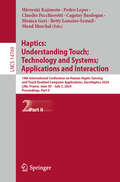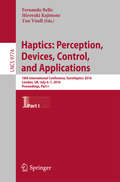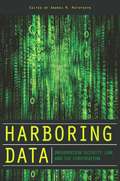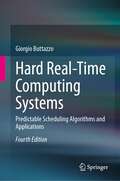- Table View
- List View
Haptic Interaction: Perception, Devices and Algorithms (Lecture Notes in Electrical Engineering #535)
by Hiroyuki Kajimoto Ki-Uk Kyung Masashi Konyo Dongjun Lee Sang-Youn KimThis book constitutes the proceedings of the third international conference AsiaHaptics 2018, held in Songdo, Korea. It presents the state-of-the-art of the diverse haptics (touch)-related research, including perception and illusion, development of haptics devices, and applications to a wide variety of fields such as education, medicine, telecommunication, navigation and entertainment. This book is a valuable resource not only for active haptics researchers, but also for general readers wishing to understand the status quo in this interdisciplinary area of science and technology.
Haptic Interfaces for Accessibility, Health, and Enhanced Quality of Life
by Troy McDaniel Sethuraman PanchanathanThis book is the first resource to provide in-depth coverage on topical areas of assistive, rehabilitative, and health-related applications for haptic (touch-based) technologies. Application topics are grouped into thematic areas spanning haptic devices for sensory impairments, health and well-being, and physical impairments which are illustrated in this book. A diverse group of experts in the field were invited to contribute different chapters to provide complementary and multidisciplinary perspectives. Unlike other books on haptics, which focus on human haptic perception, specific modalities of haptics (e.g., realistic haptic rendering), or broadly cover the subfields of haptics, this book takes an application-oriented approach to present a tour of how the field of haptics has been advanced with respect to important, impactful thematic focuses.Under Theme 1 “Sensory Impairments”, haptics technologies to support individuals with sensory impairments is presented which includes: Spatial awareness in sensory impairments through touch; Haptically-assisted interfaces for persons with visual impairments; and Enabling learning experiences for visually impaired children by interaction design. Under Theme 2 “Haptics for Health and Well-Being”, haptics technologies aimed at supporting exercise and healthy aging will be covered including: Haptics in rehabilitation, exergames and health; Therapeutic haptics for mental health and well-being; and Applications of haptics in medicine. Under Theme 3 “Haptics for Physical Impairments”, haptics technologies for enhancing the quality of life for individuals with weakened/impaired limbs or neurological diseases impacting movement is targeted including: Assistive soft exoskeletons with pneumatic artificial muscles; Haptics for accessibility in rehabilitative hardware; and intelligent robotics and immersive displays for enhancing haptic interaction in physical rehabilitation environments.Engineers, scientists, and researchers working in the areas of haptics, multimedia, virtual/augmented/mixed-reality, human-computer interaction, assistive technologies, rehabilitative technologies, healthcare technologies, and/or actuator design will want to purchase this book. Advanced level students and hobbyists interested in haptics will also be interested in this book.
Haptic Rendering for Simulation of Fine Manipulation
by Dangxiao Wang Jing Xiao Yuru ZhangThis book introduces the latest progress in six degrees of freedom (6-DoF) haptic rendering with the focus on a new approach for simulating force/torque feedback in performing tasks that require dexterous manipulation skills. One of the major challenges in 6-DoF haptic rendering is to resolve the conflict between high speed and high fidelity requirements, especially in simulating a tool interacting with both rigid and deformable objects in a narrow space and with fine features. The book presents a configuration-based optimization approach to tackle this challenge. Addressing a key issue in many VR-based simulation systems, the book will be of particular interest to researchers and professionals in the areas of surgical simulation, rehabilitation, virtual assembly, and inspection and maintenance.
Haptic Rendering: Foundations, Algorithms, and Applications
by Ming C. Lin Miguel A. OtaduyFor a long time, human beings have dreamed of a virtual world where it is possible to interact with synthetic entities as if they were real. It has been shown that the ability to touch virtual objects increases the sense of presence in virtual environments. This book provides an authoritative overview of state-of-theart haptic rendering algorithms
Haptic Systems Architecture Modeling
by Anton Weber Schahram DustdarThe present work showcases a novel approach to modeling systems architectures by utilizing Lego bricks and RFID technology. The presented solution can be used by systems and software architects to communicate their design decisions with other stakeholders in the developments process such as customers and managers involved. The software provided in this book helps to get a concrete tool showing how the approach can be applied. If the reader is interested in experimenting with this approach, they will need to purchase LEGO © blocks and the required RFID technology needed for this.
Haptic Teleoperation Systems
by Jae-Young Lee Shahram PayandehThis book examines the signal processing perspective in haptic teleoperation systems. This text covers the topics of prediction, estimation, architecture, data compression and error correction that can be applied to haptic teleoperation systems. The authors begin with an overview of haptic teleoperation systems, then look at a Bayesian approach to haptic teleoperation systems. They move onto a discussion of haptic data compression, haptic data digitization and forward error correction.
Haptic and Audio Interaction Design: 11th International Workshop, HAID 2022, London, UK, August 25–26, 2022, Proceedings (Lecture Notes in Computer Science #13417)
by Stefano Papetti Charalampos Saitis Ildar FarkhatdinovThis book constitutes the refereed proceedings of the 11th International Conference on Haptic and Audio Interaction Design, HAID 2022, held in London, UK, in August 2022. The 13 full papers presented were carefully reviewed and selected from 19 submissions that were sent for peer review. The papers are organized in topical sections on accessibility, perception, design and applications, and musical applications.
Haptics (The MIT Press Essential Knowledge Series)
by Lynette JonesAn accessible, nontechnical overview of active touch sensing, from sensory receptors in the skin to tactile surfaces on flat screen displays. Haptics, or haptic sensing, refers to the ability to identify and perceive objects through touch. This is active touch, involving exploration of an object with the hand rather than the passive sensing of a vibration or force on the skin. The development of new technologies, including prosthetic hands and tactile surfaces for flat screen displays, depends on our knowledge of haptics. In this volume in the MIT Press Essential Knowledge series, Lynette Jones offers an accessible overview of haptics, or active touch sensing, and its applications. Jones explains that haptics involves integrating information from touch and kinesthesia—that is, information both from sensors in the skin and from sensors in muscles, tendons, and joints. The challenge for technology is to reproduce in a virtual world some of the sensations associated with physical interactions with the environment. Jones maps the building blocks of the tactile system, the receptors in the skin and the skin itself, and how information is processed at this interface with the external world. She describes haptic perception, the processing of haptic information in the brain; haptic illusions, or distorted perceptions of objects and the body itself; tactile and haptic displays, from braille to robotic systems; tactile compensation for other sensory impairments; surface haptics, which creates virtual haptic effects on physical surfaces such as touch screens; and the development of robotic and prosthetic hands that mimic the properties of human hands.
Haptics Technologies
by Jongeun Cha Mauricio Orozco Mohamad Eid Abdulmotaleb El SaddikThe term "haptics" refers to the science of sensing and manipulation through touch. Multiple disciplines such as biomechanics, psychophysics, robotics, neuroscience, and software engineering converge to support haptics, and generally, haptic research is done by three communities: the robotics community, the human computer interface community, and the virtual reality community. This book is different from any other book that has looked at haptics. The authors treat haptics as a new medium rather than just a domain within one of the above areas. They describe human haptic perception and interfaces and present fundamentals in haptic rendering and modeling in virtual environments. Diverse software architectures for standalone and networked haptic systems are explained, and the authors demonstrate the vast application spectrum of this emerging technology along with its accompanying trends. The primary objective is to provide a comprehensive overview and a practical understanding of haptic technologies. An appreciation of the close relationship between the wide range of disciplines that constitute a haptic system is a key principle towards being able to build successful collaborative haptic environments. Structured as a reference to allow for fast accommodation of the issues concerned, this book is intended for researchers interested in studying touch and force feedback for use in technological multimedia systems in computer science, electrical engineering, or other related disciplines. With its novel approach, it paves the way for exploring research trends and challenges in such fields as interpersonal communication, games, or military applications.
Haptics for Virtual Reality and Teleoperation
by Matjaž Mihelj Janez PodobnikThis book covers all topics relevant for the design of haptic interfaces and teleoperation systems. The book provides the basic knowledge required for understanding more complex approaches and more importantly it introduces all issues that must be considered for designing efficient and safe haptic interfaces. Topics covered in this book provide insight into all relevant components of a haptic system. The reader is guided from understanding the virtual reality concept to the final goal of being able to design haptic interfaces for specific tasks such as nanomanipulation. The introduction chapter positions the haptic interfaces within the virtual reality context. In order to design haptic interfaces that will comply with human capabilities at least basic understanding of human sensors-motor system is required. An overview of this topic is provided in the chapter related to human haptics. The book does not try to introduce the state-of-the-art haptic interface solutions because these tend to change quickly. Only a careful selection of different kinematic configurations is shown to introduce the reader into this field. Mathematical models of virtual environment, collision detection and force rendering topics are strongly interrelated and are described in the next two chapters. The interaction with the virtual environment is simulated with a haptic interface. Impedance and admittance based approaches to haptic robot control are presented. Stability issues of haptic interaction are analyzed in details and solutions are proposed for guaranteeing stable and safe operation. Finally, haptic interaction is extended to teleoperation systems. Virtual fixtures which improve the teleoperation and human-robot cooperation in complex environments are covered next and the last chapter presents nanomanipulation as one specific example of teleoperation.
Haptics: 11th International Conference, EuroHaptics 2018, Pisa, Italy, June 13-16, 2018, Proceedings, Part I (Lecture Notes in Computer Science #10893)
by Domenico Prattichizzo Hiroyuki Shinoda Hong Z. Tan Emanuele Ruffaldi Antonio FrisoliThe two-volume set LNCS 10893 and 10894 constitutes the refereed proceedings of the 11th International Conference EuroHaptics 2018, held in Pisa, Italy, in June 2018. The 95 papers (40 oral presentations and554 poster presentations) presented were carefully reviewed and selected from 138 submissions. These proceedings reflect the multidisciplinary nature of EuroHaptics and cover all aspects of haptics, including neuroscience, psychophysics, perception, engineering, computing, interaction, virtual reality and arts.
Haptics: 11th International Conference, EuroHaptics 2018, Pisa, Italy, June 13-16, 2018, Proceedings, Part II (Lecture Notes in Computer Science #10894)
by Domenico Prattichizzo Hiroyuki Shinoda Hong Z. Tan Emanuele Ruffaldi Antonio FrisoliThe two-volume set LNCS 10893 and 10894 constitutes the refereed proceedings of the 11th International Conference EuroHaptics 2018, held in Pisa, Italy, in June 2018. The 95 papers (40 oral presentations and 554 poster presentations) presented were carefully reviewed and selected from 138 submissions. These proceedings reflect the multidisciplinary nature of EuroHaptics and cover all aspects of haptics, including neuroscience, psychophysics, perception, engineering, computing, interaction, virtual reality and arts.
Haptics: 12th International Conference, EuroHaptics 2020, Leiden, The Netherlands, September 6–9, 2020, Proceedings (Lecture Notes in Computer Science #12272)
by Michaël Wiertlewski Ilana Nisky Jess Hartcher-O’Brien Jeroen SmeetsThis open access book constitutes the proceedings of the 12th International Conference on Human Haptic Sensing and Touch Enabled Computer Applications, EuroHaptics 2020, held in Leiden, The Netherlands, in September 2020. The 60 papers presented in this volume were carefully reviewed and selected from 111 submissions. The were organized in topical sections on haptic science, haptic technology, and haptic applications. This year's focus is on accessibility.
Haptics: 13th International Conference on Human Haptic Sensing and Touch Enabled Computer Applications, EuroHaptics 2022, Hamburg, Germany, May 22–25, 2022, Proceedings (Lecture Notes in Computer Science #13235)
by Claudio Pacchierotti Thorsten A. Kern Hasti Seifi Oliver Schneider Astrid M. L. Kappers Knut Drewing Alireza Abbasimoshaei Gijs HuismanThis open access book constitutes the proceedings of the 13th International Conference on Human Haptic Sensing and Touch Enabled Computer Applications, EuroHaptics 2022, held in Hamburg, Germany, in May 2022.The 36 regular papers included in this book were carefully reviewed and selected from 129 submissions. They were organized in topical sections as follows: haptic science; haptic technology; and haptic applications.
Haptics: 14th International Conference on Human Haptic Sensing and Touch Enabled Computer Applications, EuroHaptics 2024, Lille, France, June 30 – July 3, 2024, Proceedings, Part I (Lecture Notes in Computer Science #14768)
by Claudio Pacchierotti Hiroyuki Kajimoto Pedro Lopes Maud Marchal Cagatay Basdogan Monica Gori Betty Lemaire-SemailThe two-volume set LNCS 14768 + 14769 constitutes the refereed proceedings of the 14th International Conference on Human Haptic Sensing and Touch Enabled Computer Applications, EuroHaptics 2024, held in Lille, France, during June 30 – July 3, 2024. The 81 full papers presented were carefully reviewed and selected from 142 submissions. They were organized in topical sections as follows: understanding touch; technology and systems; applications and interaction.
Haptics: 14th International Conference on Human Haptic Sensing and Touch Enabled Computer Applications, EuroHaptics 2024, Lille, France, June 30 – July 3, 2024, Proceedings, Part II (Lecture Notes in Computer Science #14769)
by Claudio Pacchierotti Hiroyuki Kajimoto Pedro Lopes Maud Marchal Cagatay Basdogan Monica Gori Betty Lemaire-SemailThe two-volume set LNCS 14768 + 14769 constitutes the refereed proceedings of the 14th International Conference on Human Haptic Sensing and Touch Enabled Computer Applications, EuroHaptics 2024, held in Lille, France, during June 30 – July 3, 2024. The 81 full papers presented were carefully reviewed and selected from 142 submissions. They were organized in topical sections as follows: understanding touch; technology and systems; applications and interaction.
Haptics: Perception, Devices, Control, and Applications
by Hiroyuki Kajimoto Yon Visell Fernando BelloThe two-volume set LNCS 9774 and 9775 constitutes the refereed proceedings of the 10th International Conference EuroHaptics 2016, held in London, UK, in July 2016. The 100 papers (36 oral presentations and 64 poster presentations) presented were carefully reviewed and selected from 162 submissions. These proceedings reflect the multidisciplinary nature of EuroHaptics and cover topics such as perception of hardness and softness; haptic devices; haptics and motor control; tactile cues; control of haptic interfaces; thermal perception; robotics and sensing; applications.
Harboring Data
by Andrea M. MatwyshynMatwyshyn (legal studies and business ethics, U. of Pennsylvania) compiles 10 articles by law and other scholars, information security professionals, and other experts from the US, UK, Canada, and Hong Kong on the business, legal, and social dynamics affecting corporate information security and data breaches. They discuss the need to adopt a multidisciplinary lens in analyzing information security; public aspects of corporate information security; protecting intellectual property assets; health, financial, and children's data, including HIPAA regulations; and changing contract law norms and new business models in social networking websites. Annotation c2010 Book News, Inc. , Portland, OR (booknews. com)
Hard Real-Time Computing Systems: Predictable Scheduling Algorithms and Applications
by Giorgio ButtazzoThis book is a basic treatise on real-time computing, with particular emphasis on predictable scheduling algorithms. The main objectives of the book are to introduce the basic concepts of real-time computing, illustrate the most significant results in the field, and provide the basic methodologies for designing predictable computing systems useful in supporting critical control applications.Hard Real-Time Computing Systems is written for instructional use and is organized to enable readers without a strong knowledge of the subject matter to quickly grasp the material. Technical concepts are clearly defined at the beginning of each chapter, and algorithm descriptions are corroborated through concrete examples, illustrations, and tables. This new, fourth edition includes new sections to explain the variable-rate task model, how to improve predictability and safety in cyber-physical real-time systems that exploit machine learning algorithms, additional coverage on Response Time Analysis, and a new chapter on implementing periodic real-time tasks under Linux..
Hard X-Ray Imaging of Solar Flares
by Michele Piana A. Gordon Emslie Anna Maria Massone Brian R. DennisThe idea for this text emerged over several years as the authors participated in research projects related to analysis of data from NASA's RHESSI Small Explorer mission. The data produced over the operational lifetime of this mission inspired many investigations related to a specific science question: the when, where, and how of electron acceleration during solar flares in the stressed magnetic environment of the active Sun.A vital key to unlocking this science problem is the ability to produce high-quality images of hard X-rays produced by bremsstrahlung radiation from electrons accelerated during a solar flare. The only practical way to do this within the technological and budgetary limitations of the RHESSI era was to opt for indirect modalities in which imaging information is encoded as a set of two-dimensional spatial Fourier components. Radio astronomers had employed Fourier imaging for many years. However, differently than for radio astronomy, X-ray images produced by RHESSI had to be constructed from a very limited number of sparsely distributed and very noisy Fourier components. Further, Fourier imaging is hardly intuitive, and extensive validation of the methods was necessary to ensure that they produced images with sufficient accuracy and fidelity for scientific applications.This book summarizes the results of this development of imaging techniques specifically designed for this form of data. It covers a set of published works that span over two decades, during which various imaging methods were introduced, validated, and applied to observations. Also considering that a new Fourier-based telescope, STIX, is now entering its nominal phase on-board the ESA Solar Orbiter, it became more and more apparent to the authors that it would be a good idea to put together a compendium of these imaging methods and their applications. Hence the book you are now reading.
Hard and Soft Computing for Artificial Intelligence, Multimedia and Security
by Janusz Kacprzyk Imed El Fray Jerzy Pejaś Shin-Ya Kobayashi Andrzej PiegatThis book gathers the proceedings of the 20th International Conference on Advanced Computer Systems 2016, held in Międzyzdroje (Poland) on October 19-21, 2016. Addressing topics that include artificial intelligence (AI), software technologies, multimedia systems, IT security and design of information systems, the main purpose of the conference and the book is to create an opportunity to exchange significant insights on this area between science and business. In particular, this expertise concerns the use of hard and soft computational methods for artificial intelligence, image and data processing, and finally, the design of information and security systems. The book contains a collection of carefully selected, peer-reviewed papers, combining high-quality original unpublished research, case studies, and implementation experiences.
Hardcore Java
by Robert Simmons JrJava has quickly become one of the most important languages in programming, particularly for professional and enterprise-level projects. From its infancy as a language primarily used for web applets to its maturity through servlets, Enterprise JavaBeans, and database access, Java has become a complex and robust tool for today's developer. Hardcore Java takes this language and breaks it apart, piece by piece, revealing the important secrets and tricks that will take you from a junior-level programmer to a seasoned and expert developer. You'll fly through the fundamentals and quickly find yourself learning about advanced memory management techniques, optimization and bytecode-level enhancements, and the techniques required to build lightning-fast GUIs. Throughout the book, you'll also master the art of writing and maintaining bulletproof and error-proof code, all while grasping the intricacies of the Java language. Hardcore Java covers: Use of the final keyword to optimize and protect your Java classes. Complete and thorough coverage of all types of nested classes, including how to optimize anonymous and inner classes. Detailed discussion of immutable objects, including unique tips on when to use them (and when not to). Elimination of bugs through exception-handling management. In-depth studies of constants, including their impact on the Java memory model. The most thorough discussion of reflection in print, moving far beyond other books' "Hello World" coverage. Construction and use of dynamic proxies, in both Java Standard and Enterprise editions. Expansive coverage of weak references, including usage patterns and their role in garbage collection and memory management. Hardcore Java is an invaluable addition to every programmer's library, and even the most advanced developers will find themselves moving beyond their own conceptions into truly advanced applications of the language. Thousands of lines of code, heavily commented and easily runnable, illustrate each concept in the book.
Hardcore Java: Secrets of the Java Masters
by Robert Simmons JrJava has quickly become one of the most important languages in programming, particularly for professional and enterprise-level projects. From its infancy as a language primarily used for web applets to its maturity through servlets, Enterprise JavaBeans, and database access, Java has become a complex and robust tool for today's developer.Hardcore Java takes this language and breaks it apart, piece by piece, revealing the important secrets and tricks that will take you from a junior-level programmer to a seasoned and expert developer. You'll fly through the fundamentals and quickly find yourself learning about advanced memory management techniques, optimization and bytecode-level enhancements, and the techniques required to build lightning-fast GUIs. Throughout the book, you'll also master the art of writing and maintaining bulletproof and error-proof code, all while grasping the intricacies of the Java language.Hardcore Java covers:Use of the final keyword to optimize and protect your Java classes.Complete and thorough coverage of all types of nested classes, including how to optimize anonymous and inner classes.Detailed discussion of immutable objects, including unique tips on when to use them (and when not to).Elimination of bugs through exception-handling management.In-depth studies of constants, including their impact on the Java memory model.The most thorough discussion of reflection in print, moving far beyond other books' "Hello World" coverage.Construction and use of dynamic proxies, in both Java Standard and Enterprise editions.Expansive coverage of weak references, including usage patterns and their role in garbage collection and memory management.Hardcore Java is an invaluable addition to every programmer's library, and even the most advanced developers will find themselves moving beyond their own conceptions into truly advanced applications of the language. Thousands of lines of code, heavily commented and easily runnable, illustrate each concept in the book.
Hardcore Programming for Mechanical Engineers: Build Engineering Applications from Scratch
by Angel Sola OrbaicetaHardcore Programming for Mechanical Engineers is for intermediate programmers who want to write good applications that solve tough engineering problems – from scratch.This book will teach you how to solve engineering problems with Python. The &“hardcore&” approach means that you will learn to get the correct results by coding everything from scratch. Forget relying on third-party software – there are no shortcuts on the path to proficiency. Instead, using familiar concepts from linear algebra, geometry and physics, you&’ll write your own libraries, draw your own primitives, and build your own applications. Author Angel Sola covers core programming techniques mechanical engineers need to know, with a focus on high-quality code and automated unit testing for error-free implementations. After basic primers on Python and using the command line, you&’ll quickly develop a geometry toolbox, filling it with lines and shapes for diagramming problems. As your understanding grows chapter-by-chapter, you&’ll create vector graphics and animations for dynamic simulations; you&’ll code algorithms that can do complex numerical computations; and you&’ll put all of this knowledge together to build a complete structural analysis application that solves a 2D truss problem – similar to the software projects conducted by real-world mechanical engineers. You'll learn: • How to use geometric primitives, like points and polygons, and implement matrices • Best practices for clean code, including unit testing, encapsulation, and expressive names • Processes for drawing images to the screen and creating animations inside Tkinter&’s Canvas widget • How to write programs that read from a file, parse the data, and produce vector images • Numerical methods for solving large systems of linear equations, like the Cholesky decomposition algorithm
Hardening Azure Applications
by Suren Machiraju Suraj GauravLearn what it takes to build large scale, mission critical applications -hardened applications- on the Azure cloud platform. This 208 page book covers the techniques and engineering principles that every architect and developer needs to know to harden their Azure/. NET applications to ensure maximum reliability and high availability when deployed at scale. While the techniques are implemented in . NET and optimized for Azure, the principles here will also be valuable for users of other cloud-based development platforms. Applications come in a variety of forms, from simple apps that can be built and deployed in hours to mega-scale apps that need significantly higher engineering rigor and robust organizations to deliver them. How do you build such massively scalable applications to keep pace with traffic demands while always being 'online' with five 9's availability? The authors take you step by step through the process of evaluating and building applications with the appropriate hardness attributes. For example, it is easy to say that an application should be available "all the time", but it is very important to understand what each level of 9 for availability means and the resulting implications on engineering and resources. The book explains the details required for developers and IT Pros to get it right in Azure. What you'll learn Why it is important to harden Azure/. NET applications and ensure they are always available. Characteristics of advanced applications Design for failure - how to avoid common mistakes and prevent failure Design for scale - prepared to scale up and scale down the application to fully leverage the best of Cloud infrastructure Techniques to secure the applications without restricting the business goals of the company How to train teams and people to run such hardened services Who this book is for Developers creating high reliability Azure applications in . NET plus most other popular environments like Java, PHP, node. JS, Python, Apache, etc. Architects and CIOs. Table of Contents 1. Overview of Azure 2. Cloud applications and their spectrum 3. Hardened cloud applications 4. Service fundamentals - Instrumentation, Telemetry and Monitoring 5. Key Application experiences - Latency, Scalability and Throughput 6. Failures and their inevitability 7. Failure detection and recovery oriented computing 8. High Availability, Scalability and Disaster Recovery 9. Availability and economics of 9s 10. Security 11. Modernization of software organizations
